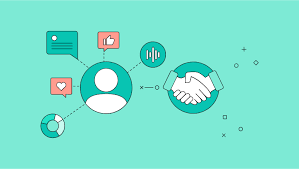 As more business goes digital, B2B companies are adopting B2C-style personalization strategies, and more business buyers expect consumer-style purchasing experiences. However, the requirements and strategies for B2B personalization differ from B2C personalization.
As more business goes digital, B2B companies are adopting B2C-style personalization strategies, and more business buyers expect consumer-style purchasing experiences. However, the requirements and strategies for B2B personalization differ from B2C personalization.
B2B personalization requires less personal information and more data about the customer’s role, business goals, and industry. B2B personalization also involves more refined segmentation than a typical B2C program, which is why many B2B marketers use account-based marketing (ABM) strategies to support their personalization programs.
- Gartner describes ABM, which targets specific groups of company contacts with personalized marketing and sales messaging, as a way for B2B sellers to “execute personalization at scale.”
- Nearly half (47%) of marketers surveyed by DemandGen said they use ABM to make sure they’re targeting the right stakeholders at companies they want to do business with.
That said, to be truly effective, B2B personalization and ABM programs need customer feedback—also referred to as voice-of-the-customer data—to create a human-centered customer experience (CX).
Human-centered CX can yield the kind of data that B2B companies need to achieve their ABM goals because it goes beyond site analytics and behavioral data to take the opinions and feedback of customers into account.
How can a human-centered CX strategy help your business?
A human-centered approach can help your company stand out and stay competitive.
There’s a growing emphasis on ABM strategies in B2B marketing: A full 61% of respondents to the previously cited DemandGen survey said they planned to spend more on ABM in the year ahead. B2B organizations will have to keep up with the improved CX that ABM, coupled with voice-of-the-customer data, can provide.
Voice-of-the-customer data can also help close the gap between customer expectations for personalization and the reality of what companies offer.
A whopping 85% of B2B customers said they expect sales reps to show that they understand their customers’ business, and nearly the same percentage (84%) said they are more likely to buy from companies that understand their customers’ business goals, Salesforce’s 2020 State of the Connected Customer report found. However, 57% of those B2B buyers said sales reps frequently don’t understand their customers’ business.
Where can you get voice-of-the-customer data?
One of the most popular ways to collect voice-of-the-customer data is by conducting surveys that collect Net Promoter Score and other information via email, text, or website form. You can also run focus groups with customers to find out what they think of your CX, products, and service delivery, and what they need or want that you don’t offer yet.
Social listening tools can round up mentions of your brand and products by customers and prospects on platforms such as LinkedIn and Facebook, reddit forums, blog posts, and review websites. That kind of feedback can help you understand customers’ pain points and get a sense of your brand’s reputation across social channels.
You can also collect and analyze the feedback customers share with your customer service and field service employees.
At the individual level, it’s important to have a process for employees to share what customers tell them. At the departmental or organizational level, speech analytics software can review word choices, tone, and emotion in customers’ speech when they call your service center, thus revealing customer satisfaction trends, problem areas, and potential solutions.
Finally, each one-on-one conversation your sales team has with customers can give you valuable insights into not only the customers’ business needs and goals but also their individual preferences in how they want to be contacted and how they prefer to make buying decisions, along with other details that can help you build a successful, highly targeted and empathetic ABM program.
How can you create human-centric B2B campaigns?
Using ABM, your marketing and sales teams can develop an ideal customer profile and use it to identify prospects that match it. From there, voice-of-customer data can help you understand what those prospective customers do, what their goals are, and what they need from vendors.
Then you can create improved individual experiences:
- More effective email messaging: For example, in outreach to new B2B prospects, industry-specific personalization is more effective than company-specific personalization. B2B buyers expect vendors to be well-versed in their industry.
- Smarter retargeting through social media and display ads: When you understand your prospects’ industry and specific goals, you can tailor your ads to fit the context of their needs and online activity.
- Personalized website experiences: Customize landing pages for your ABM targets and display the most relevant products or services when those targets visit your sales portal.
* * *
Although personalization can give B2B buyers the B2C experience they want and ABM can help vendors deploy personalized strategies at a scale that makes sense for their sales goals, listening to customers and acting on the information they share leads to a human-centered experience.
By integrating voice-of-the-customer data into your ABM, you’ll start the conversations and build the relationships that lead to sales and growth.
—
Guest Author: David Fletcher
This article first appeared in www.marketingprofs.com
Seeking to build and grow your brand using the force of consumer insight, strategic foresight, creative disruption and technology prowess? Talk to us at +971 50 6254340 or engage@groupisd.com or visit www.groupisd.com/story
